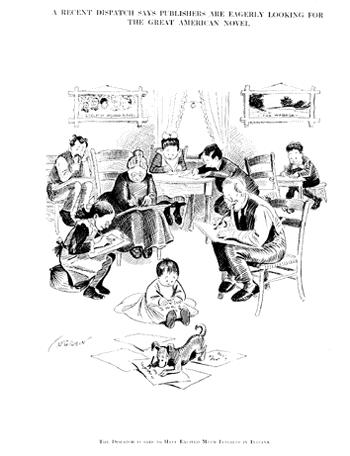

"Everyone in the State [Indiana] is either a politician or writer. Of course there's a fair sprinkling of tradesmen an' farmers, but only enough t' supply the wants of the writers and politicians."
From approximately 1880 to 1920, Indiana experienced what came to be known as the "Golden Age of Indiana Literature" in which Hoosier authors achieved both national prominence and popular acclaim.
Indiana writers catered to readers who preferred writing that idealized traditional values or offered escape from an ever-changing world. A 1947 study found that Hoosier authors ranked second to New York in the number of best-sellers produced in the previous 40 years.
From the local color poetry of James Whitcomb Riley; the historical romances of Lew Wallace, Maurice Thompson, and Charles Major; the humor of George Ade and Frank McKinney "Kin" Hubbard; the fantasy of George Barr McCutcheon; the nature writing of Gene Stratton-Porter; the homespun wisdom of Juliet Strauss, the "Country Contributor"; the grim realism of Theodore Dreiser; and the mild realism of Booth Tarkington and Meredith Nicholson, Hoosier authors worked in a variety of writing styles.
Many of these authors' works were printed by an Indianapolis publishing firm, the Bobbs-Merrill Company, which was led by editor David Laurance Chambers. By 1915 the firm had produced 26 titles that made the annual lists of top ten best-sellers, a mark surpassing all other publishers in the country during this period. Along with a publishing house, numerous literary organizations sprang up to minister to those afflicted with the writing bug: the Indianapolis Literary Club in 1877, the Terre Haute Literary Club in 1881, the Ouiatenon Club (Crawfordsville) in 1883 and the Western Association of Writers in 1886.
The lustrous Golden Age of Indiana Literature began to fade as changes in America's economic and social order accelerated after World War I. Traditional values, simple pleasures, nostalgia and romance were less important to a postwar society preoccupied with business prosperity and such technological advances as the automobile, radio and motion pictures. Throughout the years, however, Indiana authors like Kurt Vonnegut, Jean Sheperd, Dan Wakefield, and others have kept alive the Hoosier state's literary traditions.
 Return to IHS home page or Hoosier Heritage page.
Return to IHS home page or Hoosier Heritage page.